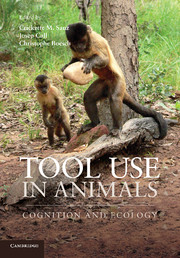Book contents
- Frontmatter
- Contents
- List of contributors
- Part I Cognition of tool use
- Part II Comparative cognition
- 4 Insight, imagination and invention: Tool understanding in a non-tool-using corvid
- 5 Why is tool use rare in animals?
- 6 Understanding differences in the way human and non-human primates represent tools: The role of teleological-intentional information
- 7 Why do woodpecker finches use tools?
- Part III Ecology and culture
- Part IV Archaeological perspectives
- Index
- References
5 - Why is tool use rare in animals?
from Part II - Comparative cognition
Published online by Cambridge University Press: 05 March 2013
- Frontmatter
- Contents
- List of contributors
- Part I Cognition of tool use
- Part II Comparative cognition
- 4 Insight, imagination and invention: Tool understanding in a non-tool-using corvid
- 5 Why is tool use rare in animals?
- 6 Understanding differences in the way human and non-human primates represent tools: The role of teleological-intentional information
- 7 Why do woodpecker finches use tools?
- Part III Ecology and culture
- Part IV Archaeological perspectives
- Index
- References
Summary
Introduction
Tool use is widespread in the animal kingdom. It has been reported in taxa ranging from insects to primates (see reviews in Beck, 1980; Bentley-Condit & Smith, 2010; Shumaker et al., 2011). However, although it is taxonomically widespread, tool use is relatively rare. The rarity of tool use is surprising given the potential evolutionary advantages that a species can gain. Tools can be used to extract rich food sources such as termites and wood-boring larvae that would otherwise be extremely difficult to obtain. Given the obvious advantages of tool use, an equally obvious question is why tool use is seen in very few species.
A glance across the species that use objects as tools rules out any simple association between the presence or absence of tool use and level of cognitive ability. Tool use is seen in insects, marine invertebrates and fish, as well as in birds and mammals. Indeed, Jane Goodall (1970) recognized that the evolutionary processes underpinning tool use across the animal kingdom will be very different. Beck (1980) emphasized that there was no simple correlation between the presence of tool use and cognitive abilities. Hansell and Ruxton (2008) recently proposed another possible explanation for the rarity of tool use in animals – that tool use was rare simply because of the lack of ecological contexts in which it was advantageous (we call this the lack-of-utility hypothesis). However, we will show here that an “excess of opportunity” clearly contradicts the lack-of-utility hypothesis because in evolutionary terms tool use appears to be potentially much more useful than its frequency in the animal kingdom indicates. Given its potential usefulness, why is tool use so rare?
- Type
- Chapter
- Information
- Tool Use in AnimalsCognition and Ecology, pp. 89 - 118Publisher: Cambridge University PressPrint publication year: 2013
References
- 54
- Cited by

